Children’s Literature IELTS Reading Answers
8 min read
Updated On
-
Copy link
Table of Contents

Limited-Time Offer : Access a FREE 10-Day IELTS Study Plan!
The Reading Module of the IELTS can be the top-scoring category, with diligent practice. To achieve the best results in this section, you must understand how to approach and answer the different Question types in the Reading Module. By solving and reviewing Sample Reading Questions from past IELTS papers, you can ensure that your Reading skills are up to the mark.
The Academic passage ‘Children’s Literature’ is a reading passage that appeared in an IELTS Test.
Since questions get repeated in the IELTS exam, these passages are ideal for practice. If you want more practice, try taking an IELTS reading practice test.
The question types found in this passage are:
Table Completion
A table of information with some gaps will be provided in the table completion question. You are required to fill the gaps with relevant responses from the given reading passage. Focus on the instructions because here, you will be asked to fill the gaps with only a few words. Read them carefully. Some of the options might confuse you, e.g., not more than three words.
Matching Features
In the Matching features type of question, there will be a list of items in the box and you need to match these items by reading and understanding some sentences in the passages. The list may be of the name of people or cities. For example, If there is a name of a person in the box of items then the question may be to match the sentences with the person who said them. Like other types of match questions, some of the items mentioned may not be available in the passage. So, to save time read the passage before answering each question.
True/False/Not Given Questions
True/false/not-given questions are very tricky. This question consists of several statements – If the statement is present in the article as it is then you need to mark it as true. If the statement is found to be the opposite of the sentence which is there then it should be marked as false. If the statement given in the question is not at all present in the article then it should be marked as not given. Do not spend a lot of time finding the sentence which is not there.
Children’s Literature
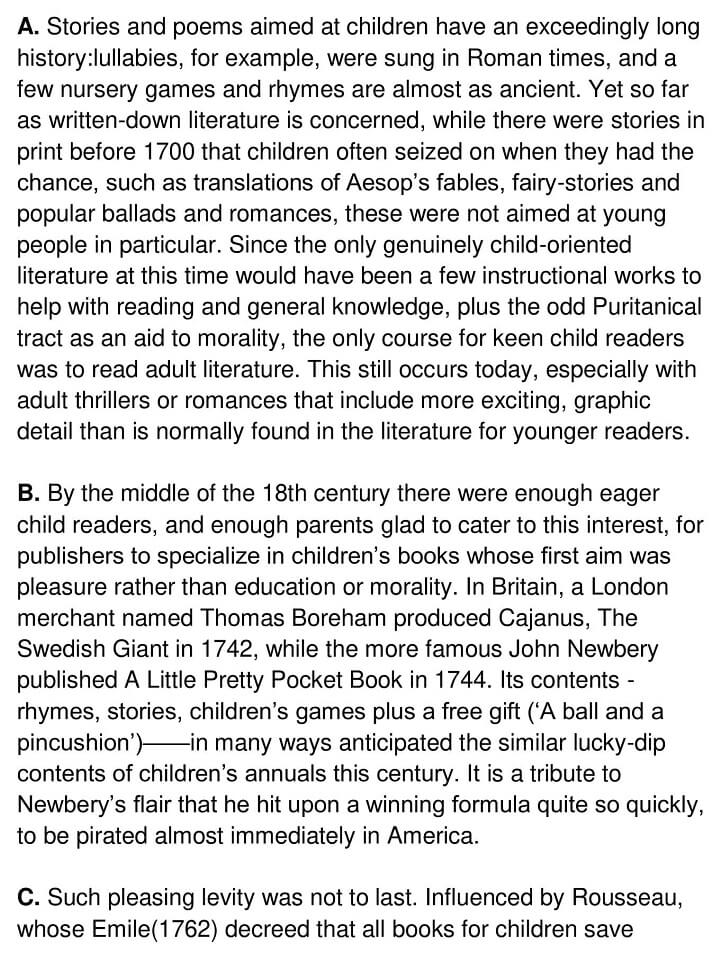
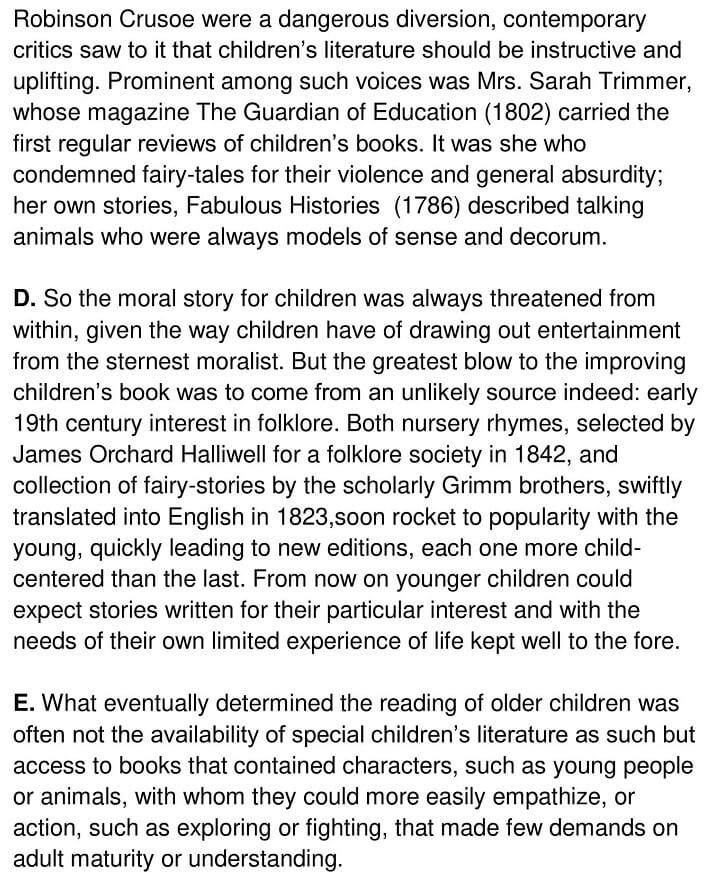
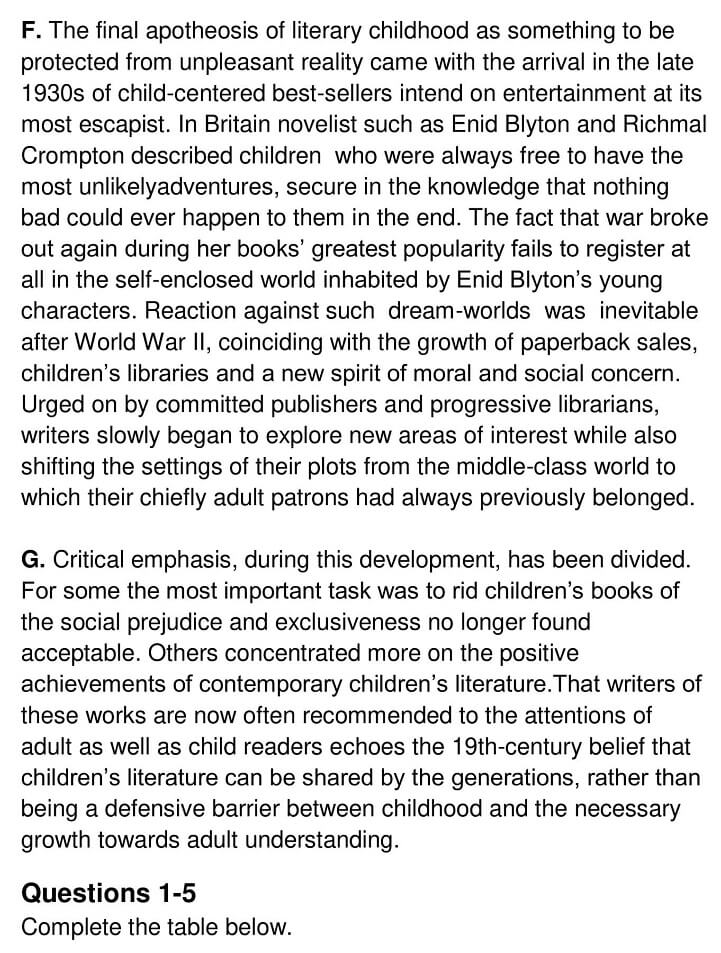
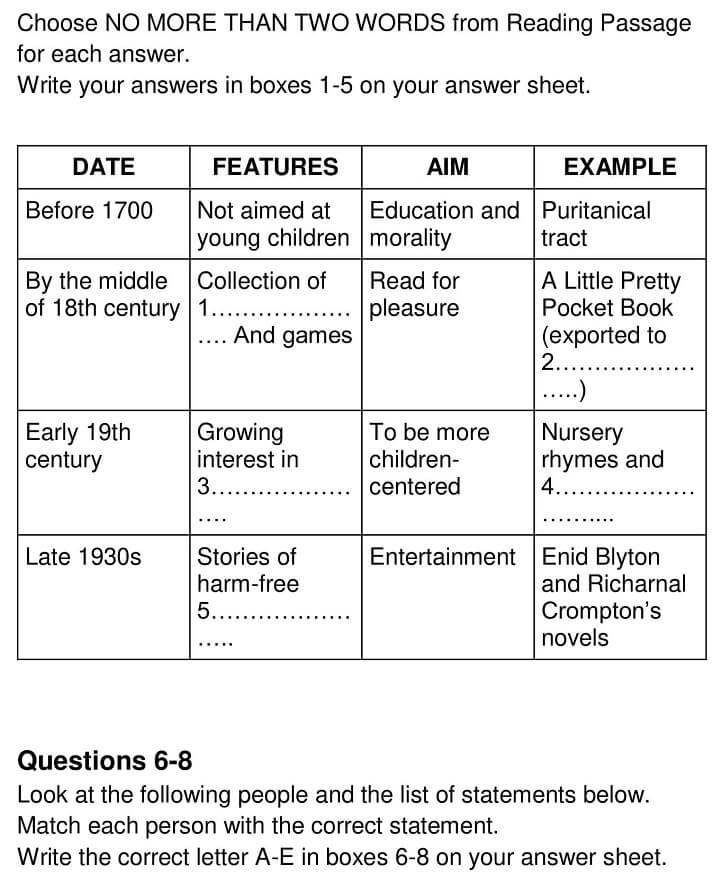

Answers
1 Answer: Rhymes, stories/ stories, rhymes
Question Type: Table Completion
Answer location: Paragraph B, line 2
Answer explanation: We can find references to the answer in Paragraph B, where the writer mentions that In Britain, a London merchant named Thomas Boreham produced Cajanus, The Swedish Giant in 1742, while the more famous John Newbery published A Little Pretty Pocket-Book in 1744. Its contents – rhymes, stories, children’s games plus a free gift (‘A ball and a pincushion’) – in many ways anticipated the similar lucky-dip contents of children’s annuals this century. So, according to the question, in the middle of the 18th century, the book’s features were a collection of rhymes and stories and games along with a free gift. Thus, the answer is rhymes, stories.
2 Answer: America
Question Type: Table Completion
Answer location: Paragraph B, last line
Answer explanation: At the end of Paragraph B, we can locate the answer, where the writer has mentioned that It is a tribute to Newbery’s flair that he hit upon a winning formula quite so quickly, to be pirated almost immediately in America. Here, pirated means exported illegally. We understand that when Newberry’s book became a hit, it was quickly pirated to America. So, the answer is America.
3 Answer: folklore
Question Type: TableCompletion
Answer location: Paragraph D, line 3
Answer explanation: The answer can be found in Paragraph D, where the writer states, “But the greatest blow to the improving children’s book was to come from an unlikely source indeed: early 19th-century interest in folklore“. We understand that in the 19th century, everyone’s interest was in folklore. So, the answer is folklore.
Unlock Answers
4 Answer: fairy stories
Question Type: Table Completion
Answer location: Paragraph D, line 4
Answer explanation: We can find the answer in Paragraph D, where it is narrated that both nursery rhymes, selected by James Orchard Halliwell for a folklore society in 1842, and a collection of fairy stories by the scholarly Grimm brothers, swiftly translated into English in 1823, soon rocket to popularity with the young, quickly leading to new editions, each one more child-centred than the last. We understand that in the early 19th century, nursery rhymes and fairy stories were very common. So, the answer is fairy stories.
5 Answer: adventures
Question Type: Table Completion
Answer location: Paragraph F, line 1
Answer explanation: We can trace the answer in Paragraph F, where the writer states that with the arrival in the late 1930s of child-centred bestsellers intend on entertainment as its most escapist, Britain novelists such as Enid Blyton and Richmal Crompton described children who were always free to have the most unlikely adventures, secure in the knowledge that nothing bad could ever happen to them in the end. We understand from the lines above that during the late 1930s, stories of harm-free adventures were quite famous. So, the answer is adventures.
6 Answer: C
Question Type: Matching features
Answer location: Paragraph B, line 2
Answer explanation: We can trace the answer in Paragraph B, where it is mentioned that in Britain, a London merchant named Thomas Boreham produced Cajanus, The Swedish Giant, in 1742. So we understand that Thomas Boreham was not a writer/author, intially. So, the answer is C. Was not a writer originally.
7 Answer: A
Question Type: Matching features
Answer location: Paragraph C, line 2
Answer explanation: The answer can be referred to in paragraph C, where it is narrated that prominent among such voices was Mrs Sarah Trimmer, whose magazine The Guardian of Education (1802) carried the first regular reviews of children’s books. We understand from the lines above that Mrs Sarah Trimmer wrote reviews as a critic for the children’s books. Here, criticism means reviews, and literature means books. Thus, the answer is A. Wrote criticism of children’s literature.
8 Answer: E
Question Type: Matching features
Answer location: Paragraph D, line 3
Answer explanation: We can track the answer in Paragraph D, where it is mentioned that a collection of fairy stories by the scholarly Grimm brothers, swiftly translated into English in 1823, soon rocket to popularity with the young, quickly leading to new editions, each one more child-centred than the last. So we understand that the Grimm brothers didn’t write fairy stories in the English Language, instead they got it translated into English language. So, the answer is E. Didn’t write in the English language.
9 Answer: FALSE
Question Type: True/False/Not Given Questions
Answer location: Paragraph A, line 2
Answer explanation: We can trace the answer in Paragraph A, where it is narrated that “Yet so far as written-down literature is concerned, while there were stories in print before 1700 that children often seized on when they had the chance,”. We understand that in 1700, the children started reading stories in print whenever they had the chance. So, the information doesn’t match with the statement. Thus, the answer is FALSE.
10 Answer: TRUE
Question Type: True/False/Not Given Questions
Answer location: Paragraph C, line 2
Answer explanation: In paragraph C, the answer can be found where the writer has mentioned that prominent among such voices was Mrs Sarah Trimmer, whose magazine The Guardian of Education (1802) carried the first regular reviews of children’s books. It was she who condemned fairy-tales for their violence and general absurdity; her own stories, Fabulous Histories (1786), described talking animals who were always models of sense and decorum. Thus, we understand that Mrs Sarah Trimmer, who wrote regular reviews for the children’s book, criticized the fairy tales for their violence and general absurdity, as she believed children’s books should set good examples. Here, “condemned” means criticizing. So, the information agrees with the statement, resulting in the answer being TRUE.
11 Answer: NOT GIVEN
Question Type: True/False/Not Given Questions
Answer location: Paragraph C, line 2
Answer explanation: According to the question, we can find references to the answer in Paragraph C, where Mrs Sarah Trimmer condemned fairy-tales for their violence and general absurdity. However, we don’t find any information relating to the parents who were concerned about the violence in the children’s book. Thus, the answer is NOT GIVEN.
12 Answer: TRUE
Question Type: True/False/Not Given Questions
Answer location: Paragraph D, line 2
Answer explanation: We can trace the answer in Paragraph D, where the writer has mentioned that the greatest blow to the improving children’s book was to come from an unlikely source indeed: early 19th-century interest in folklore. We understand that interest grew among the people when folklore was introduced in the early 19th century, changing the direction of development of children’s books. Here, improving means developing. As the information agrees with the statement, the answer is TRUE.
13 Answer: TRUE
Question Type: True/False/Not Given Questions
Answer location: Paragraph G, last line
Answer explanation: We can locate the answer in Paragraph G, where the writer has mentioned that the writers of these works are now often recommended to the attention of adult as well as child readers echo the 19th-century belief that children’s literature can be shared by the generations, rather than being a defensive barrier between childhood and the necessary growth towards adult understanding. So, we understand that nowadays, the children’s book writers believe that their books should attract both children and adults. So, the answer is TRUE.
Check More IELTS Reading Answers
Also check :
Practice IELTS Reading based on question types

Start Preparing for IELTS: Get Your 10-Day Study Plan Today!
Recent Articles

Nehasri Ravishenbagam

Haniya Yashfeen

Haniya Yashfeen

Haniya Yashfeen
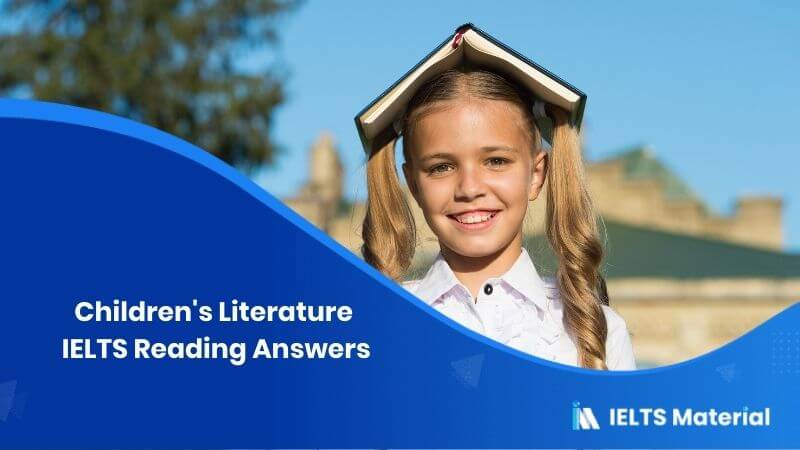



Post your Comments